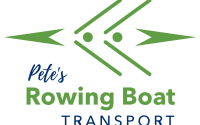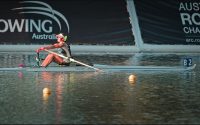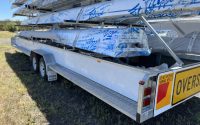Taking the next step in your rowing (or that of your crew)
The year 2020 was a time of introspection for us all, as we had a chance to slow down and realise what is profoundly important in life. As part of this process for a lot of people that may have included setting some new goals for their rowing, or for the crews and athletes they coach.
As we look forward to 2021 and realising some of those goals, Rowtrade is pleased to offer a brief run down of some key elements that you can address in taking the next step in your performance.
The beauty of rowing is that no matter how long you have been rowing for, it is almost impossible to achieve perfection. We compete independent of our competitors so we can focus on our own performance and the sport does reward persistence and consistency far more than talent.
Here is a run down of some key areas that will ensure 2021 will be your best season yet.
Equipment – The Correct Set Up For You
When we talk about equipment, this is not necessarily about buying a new boat or oars. Sure, if you have a 15 year old single scull or something that is significantly overweight or made from single skin fibreglass construction then you may want to update. More important than this is to ensure the set up in the boat is appropriate for you. This is a key benefit of having your own boat in that you can have the boat set up specifically for you, and you are not turning up to use a club boat that is uncomfortable, the wrong size, or requires you to spend more time adjusting heights/angles to your liking than you spend out on the water.
Unless you are a very experienced rower, it is important that you get assistance (from someone that knows what they are doing) in setting up your boat. The pitch/lay of the pin, feet height, gate height, feet angle and your footstretcher position relative to the pin are all crucial in making sure you are comfortable and can perform at your best. Another huge benefit of correct set up is that your risk of injury is reduced substantially.
If your boat is not the correct size for you then you need to address this as training in inappropriate equipment can compromise your performance.
Rowing is a hugely technical sport. You can be the strongest person in the world on the rowing machine, but I can assure you that you can do all the training in the world but if you are not set up correctly you will be sacrificing huge amounts of speed (and comfort) on the water.
Technique – Do the Fundamentals Well
Rowing is a sport with many different layers. It is easy to go down different rabbit holes in finding “free speed”. Rather than exploring the complexities of the sport, athletes and coaches would benefit greatly from focussing on the basics. Doing the basics well will put you in front of nearly all your competition.
Broadly speaking, a really easy way to understand what is important in rowing is to watch a novice attempt to row and then watch an elite rower compete. There are a few fundamental areas where all of us can focus our technical efforts:
- Posture: Sit up as tall as possible in the boat
- Sequence of movement: Arms, body, legs on the recovery then legs, bodies arms on the drive
- Use your legs: Intuitively people row with their arms (“Oh you are a rower, you must have strong arms!”), you want to hang with your arms and row with your leg drive and body open (through your hips), arms are 1% of the drive phase
- Grip: this is massively important in controlling the blade, know how to hold the handle correctly – if you are unsure ask someone that is experienced for help
- Blade work: ensure you are rowing turns in the boat, tap down and clear of the water at the release and carry your blades away from the water on the recovery. Place the blade in the water at the catch prior to driving the legs
- Rhythm: Understand the way the boat is moving through the water and the way your own movement interacts with the boat. Where is the boat moving at it’s fastest in the stroke cycle, where is it moving at its slowest?
- Slowing down the least: winning rowing races is about slowing down less than your competition. There are two phases to the rowing stroke, the recovery phase and the drive phase. Power is important but efficiency and not slowing the boat down on the recovery is just as important. Both represent opportunities to improve
If you have time get on Youtube and look at the footage of the 2020 European Championships or the 2019 World Championships. The Dutch men’s quad and the Danish men’s single sculler are real stand outs in how beautifully they row.
Cognitive Application – No Junk Miles!
Engaging mentally in what you are doing will make a huge difference. The same number of strokes, the same number of minutes training, same number of sessions with completely different outcomes depending on your level of mental engagement with what you are trying to do. Avoid junk miles!
It is worth exploring exercises that you can do in the boat to improve and understand why the exercise is important and what it can teach you. It is also important to think about points 6 & 7 above when you are rowing. Apply your own intelligence to getting the bow ball from the start line to the finish line as quickly as possible.
Ensuring you get some coaching will help you to understand what you can focus on, and make large gains in a short period of time. If your club does not have a regular coach, ask the committee to organise for a coach to come in a few times a year to assist the members.
Consistency in Your Training
Doing 15 sessions of training one week and then injuring yourself and missing two weeks of training subsequently is not the way to improve. The key is to establish a training routine and stick with this over an extended period of time. If you intend to compete in a major regatta, give yourself several months to gradually and systematically prepare for the event.
The great thing about rowing is that natural talent will only get you so far. No other sport rewards consistency in effort and persistence more than rowing.
If you are not a world beater today it does not matter! Set your own goals and be consistent in doing what you need to do to achieve them. If you do the work you will get the outcomes you desire.
Specificity – Row to Improve Your Rowing
Have you ever seen a swimmer on a bicycle to improve their swimming? Of course not. While there is a large correlation between rowing and cycling performance, unless you are an elite rower with an infinite amount of time to train each week it is important that the time you do have is used on the water as much as possible. Sitting on a bike will not improve your catch!
Similarly, if you are planning on racing in some regattas and your aim is to sit on 2:00/500m splits at a stroke rating of 34spm then floating up and down the river at a stroke rating of 18spm is probably not going to be particularly useful on race day! You need to do some minutes training at the speed and intensity that you aim to race at.
Finally, get out there and race! So many rowers spend so much time training (boring!) and so little time racing (fun!). If you want to target a particular regatta then the best thing you can do between now and your target regatta is to race as much as possible. I have been rowing for 33 years and I still learn something every time I race. You also need to go through the routine of being on the start line and working through the different phases of the race so that I race day you know what to expect. If you think you can benefit more from a training day than a racing day then I would have to ask what you did in your other training sessions that week?
We row to race, not to train!
While rowing machine serve a purpose the Concept 2 static machine in no way resembles rowing on the water. If you do need to do some of your training on the rowing machine then try and use a dynamic rowing machine like an RP3 or a Concept 2 dynamic where you can (or at the very least use the sliders with the Concept 2 machine) Your lower back will thank you for it and you will also be able to practice the rhythm you intend to row in the boat.
Strength and Flexibility
In an ideal world we would all do regular strength and flexibility training in addition to our on-water training. However for masters rowers or school aged athletes this is not always realistic.
On water rowing should always be the priority. I would then prioritise flexibility training over strength training if you are unable to do both.
You can search “Yoga with Adriene” on Youtube as a great way of getting some variety in your flexibility and core training from a woman that knows her stuff.
If you do have time to do some strength training it is best if you seek guidance from a strength coach with experience in rowing and the specific demands of the sport.
Regular Testing – Be Rewarded
Like achieving any goal testing is important. I would suggest you set some goals on the rowing machine that will allow you to see the improvement you are making. I would suggest monthly testing at the following distances:
- 30 minute rating 20 (only for more experienced rowers)
- 5km time trial – for school aged or masters rowers rate cap this to around 28spm
- 2km time trial – for those racing 2km events
- 1km time trial – for those racing 1km events
Be sure to control for as many variables as possible. Time of day (you will perform better in the afternoon compared to the early morning), diet leading up to the testing, training load leading up to the testing, the machine you use (try and use the same machine each time) and the drag factor of the machine (calibrate it each time). Keep a database of your scores and track your progress.
Remember your technique on the machine should reflect what you want to do in the boat and is very important for achieving your best results – even on the rowing machine.
If you are not improving, get some assistance from a coach or more experienced rowers.
General Health and Nutrition
Your improvement should be a function of consistency over time in all domains. For non-elite rowers an emphasis on rowing as part of your overall health and wellbeing should be the focus. A huge number of people row for the mental health benefits that come from being out on the water.
Your nutrition should also reflect your goals (I think we all know what a good diet is) but be conducive to a healthy body composition over time.
Ultimately you should enjoy what you are doing. If you need assistance with achieving your goals, then reach out because everyone in Australian rowing wants to support and encourage others.
Conclusion
Ultimately we all row because it is an amazing sport for many reasons. The above is about helping you to identify areas where you may find improvement and more satisfaction from the time you put into training. If you have any questions on anything written above please do not hesitate to contact me.
Alastair Isherwood has rowed for 33 years, coached for over 25 years, is a World Champion rower and former Head Coach at Mercantile Rowing Club. He still rows and races as much as life will allow. For support contact him at al@perfectbalancerowing.com
Further reading:



